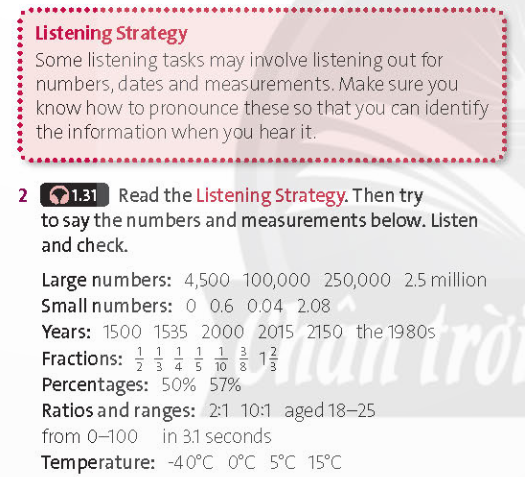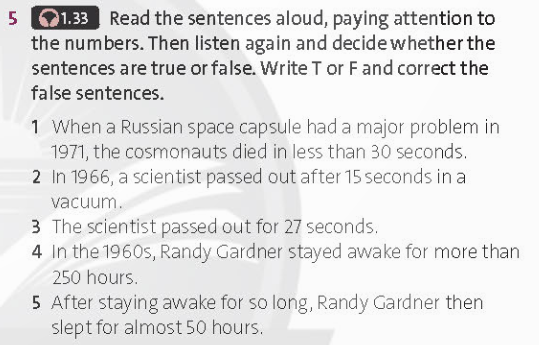Tiếng Anh 11 Friends Global Unit 3 3C Listening
Giải Tiếng Anh 11 Friends Global Unit 3 trang 39
Giải bài tập SGK tiếng Anh 11 Friends Global Unit 3 3C Listening trang 39 hướng dẫn giải chi tiết các phần bài tập trong Sách giáo khoa tiếng Anh lớp 11 Friends Global giúp các em học sinh chuẩn bị bài tập tại nhà hiệu quả.
1. SPEAKING Describe and compare the photos. What are the similarities and differences between the activities? Use the words below to help you.
(Mô tả và so sánh các bức ảnh. Những điểm tương đồng và khác biệt giữa các hoạt động là gì? Sử dụng các từ dưới đây để giúp bạn.)

Gợi ý đáp án
Looking at the pictures I can see they are running in the desert and the second picture shows the man who is staying in a tent on a cold mountain covered with a lot of snow. The people in the first picture, I guess they are taking part in a running activity because they have numbers on their T-shirts. They look really tired because of the hot weather and I guess they are becoming dehydrated. By contrast, in the second picture, the weather is frostbite because the main color of the picture is the color of snow. The man is sitting on the top of the mountain with a high altitude. He is also wearing a face mask to supply oxygen. I guess he is a climber, and he wants to conquer this mountain.
(Nhìn vào hai bức ảnh, tôi nghĩ cả hai đều đang mô tả những môn thể thao mạo hiểm thực sự khó thực hiện. Trong bức ảnh đầu tiên, tôi có thể thấy họ đang chạy trên sa mạc và bức ảnh thứ hai cho thấy người đàn ông đang ở trong lều trên một ngọn núi lạnh giá có nhiều tuyết bao phủ. Những người trong bức ảnh đầu tiên, tôi đoán họ đang tham gia một hoạt động đang chạy vì họ có số trên áo phông của họ. Họ trông thực sự mệt mỏi vì thời tiết nóng và tôi đoán họ đang bị mất nước. Ngược lại, ở bức tranh thứ hai, thời tiết lạnh cóng vì màu chủ đạo của bức tranh là màu của tuyết. Người đàn ông đang ngồi trên đỉnh núi rất cao. Anh ấy cũng đang đeo mặt nạ để cung cấp oxy. Tôi đoán anh ấy là một nhà leo núi và anh ấy muốn chinh phục ngọn núi này.)
2. Read the Listening Strategy. Then try to say the numbers and measurements below. Listen and check.
(Đọc Chiến lược nghe. Sau đó cố gắng nói các con số và phép đo dưới đây. Nghe và kiểm tra.)
Bài nghe

3. Read and listen to the article. Complete the article with numbers and measurements from exercise 2.
(Đọc và nghe bài viết. Hoàn thành bài viết với các số và phép đo từ bài tập 2.)
Bài nghe

Gợi ý đáp án
|
1. -400C |
2. 50C |
3. 150C |
4. 50% |
|
5. 57% |
6. 4,500 |
7. 1/5 |
8. 1/10 |
Nội dung bài nghe
There are many amazing stories of human survival, but actually our bodies are very fragile and do not cope well with extremes. Polar explorers can cope with temperatures of −40°C, but only if they keep warm. Most people will collapse if their body temperature drops by only 5°C, and if it drops by 15°C, they’ll die. Heat can be just as dangerous. Temperatures of 35°C are safe provided humidity is not above 50%. High altitudes are dangerous too. We pass out when the pressure falls below 57% of normal atmospheric pressure. This happens at about 4,500 metres. Climbers can go higher because their bodies gradually get used it, but no one survives for long at 8,000 metres. At high altitudes, lack of oxygen is another problem. At ground level, about 1/5 of the air is oxygen. If that falls below 1/10, we die.
4. Listen to an interview with a scientist. Which of the people he talks about tested the body's limits deliberately?
(Nghe cuộc phỏng vấn với một nhà khoa học. Ai trong số những người mà anh ấy nói về đã cố tình kiểm tra giới hạn của cơ thể?)
Bài nghe
Gợi ý đáp án
Randy Gardner
5. Read the sentences aloud, paying attention to the numbers. Then listen again and decide whether the sentences are true or false. Write T or F and correct the false sentences.
(Đọc to các câu, chú ý đến các con số. Sau đó nghe lại và quyết định xem câu đó đúng hay sai. Viết T hoặc F và sửa các câu sai.)
Bài nghe

Gợi ý đáp án
|
1. F |
2. T |
3. F |
4. T |
5. F |
Lời giải chi tiết
1 - Khi một khoang vũ trụ của Nga gặp sự cố nghiêm trọng vào năm 1971, các phi hành gia đã chết trong vòng chưa đầy 30 giây.
Thông tin: Three Russian cosmonauts died in 1971 when their space capsule had a major problem atan altitude of 168 kilometres. The pressure inside the capsule dropped to zero and the crew died after 30 to 40 seconds.
2. Năm 1966, một nhà khoa học đã bất tỉnh sau 15 giây trong chân không.
Thông tin: In 1966 a scientist was testing a spacesuit in a special room when the pressure suddenly dropped to almost zero for a period of 27 seconds. He passed out after 15 seconds and he woke up when the pressure inside the room returned to normal.
3. Nhà khoa học bất tỉnh trong 27 giây.
Thông tin: In 1966 a scientist was testing a spacesuit in a special room when the pressure suddenly dropped to almost zero for a period of 27 seconds.
4. Vào những năm 1960, Randy Gardner đã thức hơn 250 giờ.
Thông tin: That’s 264 hours.
5. Sau khi thức quá lâu, Randy Gardner sau đó đã ngủ gần 50 giờ.
Thông tin: His first sleep after those 11 days lasted almost 15 hours.
6. PRONUNCIATION Listen and mark the words that are stressed in the sentences from exercise 5. Then practise saying the sentences yourself.
(Nghe và đánh dấu những từ được nhấn trọng âm trong các câu ở bài tập 5. Sau đó tự luyện nói các câu đó.)
Bài nghe
Gợi ý đáp án
1. When a Russian space CAPSULE had a major PROBLEM in 1971, the COSMONAUTS DIED in less than 30 SECONDS.
2. In 1966, a SCIENTIST PASSED out after 15 SECONDS in a VACUUM.
3. THE SCIENTIST PASSED out for 27 SECONDS.
4. In the 1960s, Randy Gardner STAYED awake for more than 250 HOURS.
5. After STAYING awake for so long, Randy Gardner then SLEPT for almost 50 HOURS.
7. SPEAKING Discuss the questions in pairs.
(Thảo luận các câu hỏi theo cặp.)

Gợi ý đáp án
A: Have you ever been awake all night or most of the night? If so, when/where/why?
B: Yes, I have. I remembered when I was in grade 9, I usually stayed up late until 2.00 to 3.00 A.M. to do my homework as well as prepare for my big examination to enter high school. It was really tiring and stressful.
A: Have you ever felt very cold? If so, when/where/why?
B: Yes, I have. That is when I went to Da Lat last year. Because I live in Ho Chi Minh city, I get used to hot weather. Therefore, when I came to Da Lat, the weather was so low, just about 15 degrees Celsius. I felt extremely cold.
A: Have you ever experienced high altitude?
B: No, I haven't. You know I'm a kind person who is very scared of heights. I also don't have any intention to try it one time in the future.
Trên đây là Unit 3 tiếng Anh lớp 11 Friends Global trang 39 đầy đủ nhất.








